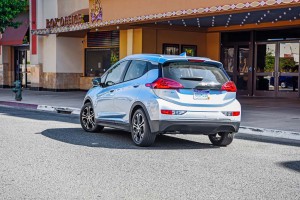The line is moving at a snail’s pace, but production of the Chevrolet Bolt is finally ramping up at the General Motors assembly plant in the Detroit suburb of Orion Township, with the first of the new, long-range battery-electric vehicles, or BEVs, set to go on sale before the end of the year.
Parent General Motors is hoping that it can steal a march on a variety of competitors, notably Tesla Motors, who hope to get their own long-range electric vehicles into showrooms over the next several years. With regulators in the U.S., Europe, Japan and China pushing the industry to expand sales of zero-emissions vehicles, the Bolt could provide the first real test of a vehicle designed to overcome so-called range anxiety.
But whether motorists will take to the $37,495 Chevy Bolt – or any of the other, more mainstream BEVs to follow is far from certain. Fully electric models have accounted for just 0.4% of the U.S. market so far this year. Adding in plug-ins and conventional hybrids, battery-based vehicles still only make up a miniscule 2.5%.
(Toyota reversing course, will build long-range EVs. Click Here for more.)
GM was the first major automaker to bring a plug-in hybrid to market, the Chevrolet Volt debuting in late 2009, just as the parent company was recovering from bankruptcy. Chevy hopes to gain first-mover advantage by being the first to enter the mainstream with a lone-range BEV. Factoring in the $7,500 federal credit buyers will be eligible for brings the cost down to $29,995.
By comparison, the 2017 Ford Focus electric starts at $29,120 before the tax credit is subtracted. The Kia Soul EV begins at $31,950. But those two models get less than half the EPA-rated 238-mile range of the Chevy Bolt.
(Chevy Bolt gets a leg up on Model 3 with 238-mile rating. Click Here for the full story.)
Industry planners have long argued that 100 miles of range is more than enough for the typical U.S. motorist, but analysts counter that Americans buy vehicles based not on what they routinely need but what might be necessary under special circumstances. They want to be able to make that unexpected trip without worrying about running out of battery power 50 miles from home.
So, a growing number of manufacturers are developing longer-range models of their own. As TheDetroitBureau.com today reported, Toyota will reverse course and launch a battery vehicle program early next year. Daimler AG announced the formation of a new BEV brand, Mercedes-EQ, during the recent Paris Motor Show. And Volkswagen is promising to have 30 battery-electric models in production by 2025.
The most immediate challenger to the Bolt will be the Tesla Model 3 which, CEO Elon Musk has promised, will be in production by the second half of 2017.
Chevy and Tesla have taken different approaches to their mainstream electric entries. The Mosel 3 is a sleek sports car expected to offer a range of upscale features. Musk has said the goal is be producing 500,000 BEVs annually by 2018 – a figure including the much more expensive Models S and X.
The Chevy Bolt is a much more utilitarian offering, with a compact crossover body and a relatively utilitarian interior. Officials with GM’s largest brand haven’t revealed sales targets, but Bolt’s battery supplier, the Korean LG Chem, recently estimated the first full year’s production at around 30,000.

The Bolt will have a headstart on competitors, notably the Tesla Model 3 by going on sale this year.
Not all of those will show up in retail use. Earlier this year, GM invested $500 million in ride-sharing firm Lyft, and the partners have launched a program aimed at offering drivers low-rate leases on GM products. Pam Fletcher, the head of GM’s battery-car program, told TheDetroitBureau.com that Bolt will be one of the vehicles offered to Lyft drivers.
The Bolt uses a unique platform designed to maximize interior space by mounting batteries below the floor. That also lowers the vehicle’s center of gravity, improving handling. The little electric vehicle can launch from 0 to 60 in just over seven seconds, another improvement over many first-generation BEVs.
Though the Bolt platform is not shared with other U.S. models, the Orion plant is flexible enough to allow the BEV to roll down the same line as the similarly sized Chevy Sonic. The factory is currently running on just one shift, paced for production of around 90,000 vehicles annually.
The Sonic sounds a note of caution as Chevy ramps up production of the Bolt. Demand for the subcompact model has slipped over the last several years, largely due to the impact of cheap gas on small and fuel-efficient models. Sales of electrified vehicles have been especially hard hit, tumbling from a high of around 4% when gas was nudging record highs, to barely 2.5% today.
But GM is cautiously upbeat that by lowering costs and raising range, motorists will no longer think of it as a sacrifice to go electric, but rather a smart, fun alternative. They’ll know soon whether American buyers are ready to plug into that scenario.
(Feds setting up 25,000-mile, 35-state alt-fuel network. Click Here to learn more.)


